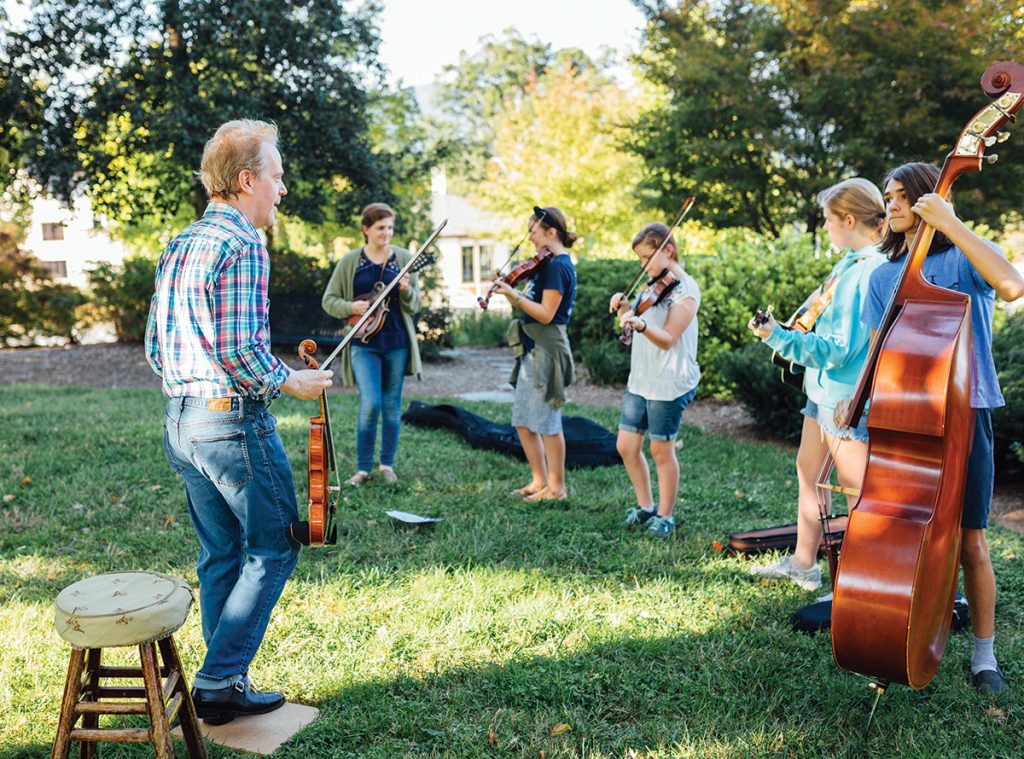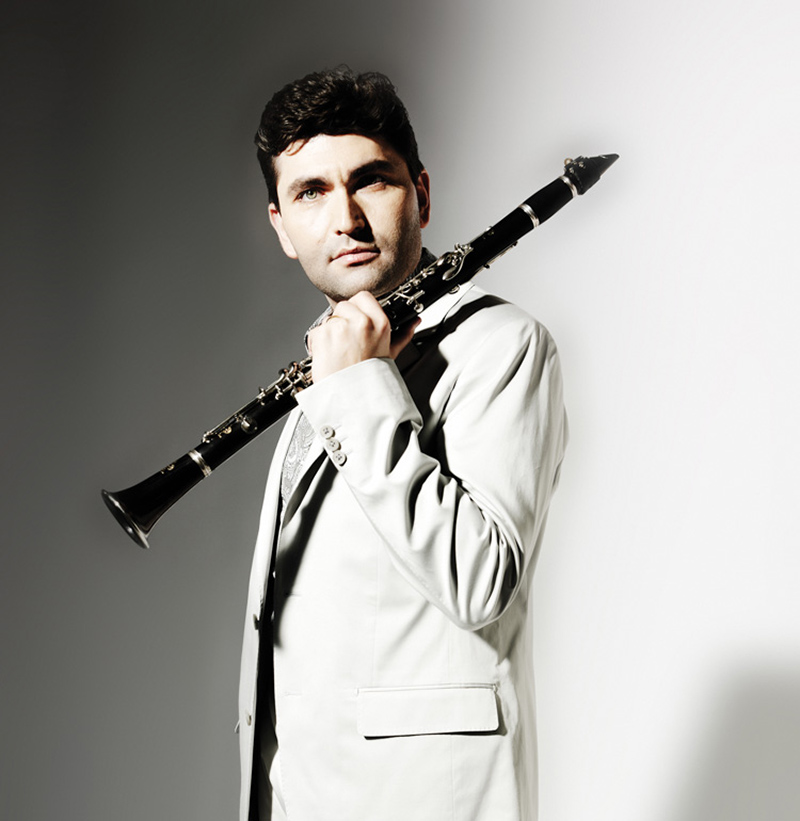Program is staunch in its traditional approach to old-time music

Instructor Jamie Laval, a well-known musician from the Tryon area, plays with his students, including Eli Aldrich on stand-up bass.
Photo by Rachel Pressley
Old-time is the Appalachian genre that came way before bluegrass. But sometimes it sounds as current as a Wednesday afternoon.
Every week since July, members of PacJAM — the microlocal chapter of the regional Junior Appalachian Musicians program — have met at Tryon Fine Arts Center to hone their skills on traditional string-band instruments. Banjos, fiddles, guitars, mandolins, ukuleles, and even standing basses and concertinas can be heard on a stroll around the building.
As its name suggests, this music is old — centuries old — and yet familiar, like patchwork quilts or the sound of moving water. (PacJAM is named after the foothills’ Pacolet River.) Groups of students stake out grassy knolls, shady spots, or park benches for lessons or just to jam.
It appears very casual — almost family-like — with after-school kids adjusting their fingering to find the right chord, and teachers patiently encouraging, suggesting, and demonstrating. A larger group of adults seemingly jam with little guidance.
What you don’t see much of is sheet music.
These old-time ballads, reels, and rags — most of Scots-Irish origin — flourished in isolated mountain communities and are collectively called “fiddle tunes.” They were passed down through the generations with players sitting “knee to knee,” not through formal instruction.

Sarah Doan plays in the Clover Pickers, a PacJAM ensemble.
Photo by Rachel Pressley
“We are preserving a regional art,” says director Julie Moore. (PacJAM is one of about 50 affiliates; the program is headquartered in Virginia.) Moore has an extensive professional background in world music, and she is also a “PacJAM mom” whose 16-year-old son, Carson, was a student and is now teaching the ukulele, guitar, mandolin, and banjo. Like most PacJAM students, he learned to play multiple instruments mostly by ear.
“These kids — and adults, too — are learning and preserving old-time music, which is folk music that predates bluegrass,” explains Moore. “It’s been only since the 1920s, with the advent of the record player, that the music reached broader audiences.” She mentions The Carter Family, one of the early groups that brought old-time music into the mainstream. “Musicians like Johnny Cash and his wife June Carter [daughter of Carter Family founding member Maybelle Carter] were greatly influenced by old-time music. Until then, the folks in Appalachia just played and evolved what they heard from each other. Music was a favorite family and community pastime.”

Erik Peña has learned guitar, mandolin, and banjo.
Photo by Rachel Pressley
On the visionary level, PacJAM goes beyond just teaching students to play instruments. A statement on the JAM website emphasizes the communal experience, picturing “all children [having] the opportunity to experience … the joy of participating in traditional mountain music together.”
Currently in its fall semester and ninth season, Tryon Fine Arts Center offers PacJAM classes for beginners through advanced musicians. Some in PacJAM are as young as 6 years old. Many adult players are 60-plus and may be picking up their instruments after decades of silence. The semester is 10 weeks long and significantly more affordable than most music schools, although scholarships are also available. According to Moore, no one has ever been turned away. Most semesters have about 43 students, plus adults. The pandemic caused a slight drop in enrollment, to the current roster of 35 students, and a move from indoor to outdoor teaching.
In keeping with tradition, all beginners are taught to play by ear: Many don’t read music at all. At first, the children listen to tunes such as “Salty Dog” and “Golden Slippers.” Once the words and melodies are in their heads, they then begin to transfer the tunes to instruments.
“It becomes ingrained in them,” Moore says. “It’s so much easier and more natural to pick out a song on the guitar if you are already familiar with it. The process becomes innate — the music comes from within, not from a page of sheet music. It becomes part of them, part of their lives. It can be the foundation for a lifetime of music, maybe even a career.”
One of the great accomplishments of PacJAM is the creation of bands or ensembles. The current band of advanced students is The Clover Pickers, six students with stringed instruments. They’ve gigged all over Upstate South Carolina: at the popular Landrum Farmers Market on Saturday mornings, at the open-air Spartanburg bar FR8yard, and at Greer’s Albino Skunk Music Festival.
Erik Peña, 12, a Polk County middle schooler, has been part of PacJAM for six years. “We play by ear, and I just catch on,” he explains. His goal is simple: “To know how to play an instrument.” Actually, he’s learned three: guitar, mandolin, and banjo. And along the way, he feels he is “keeping history going. It’s fun to learn history and play it again.”
Clover Picker Sarah Doan, 14, is a homeschooler in eighth grade. She’s been with PacJAM for five years and plays the mandolin and fiddle. She admits that she can read music, “but not very well. I play mostly by ear. I like when I can pick out a church hymn. I think it’s neat to just start playing and not think very much. I like playing with friends and singing. That’s what I enjoy. It’s important to preserve what ancestors have played, and I like carrying on a family tradition.”
Asked more about her violin, she quickly and adamantly corrects the word choice: “No! It will always be a fiddle to me.”
PacJAM’s fall-semester concert, a public event, happens Wednesday, Nov. 17, at 5pm at the Tryon Fine Arts Center amphitheater (34 Melrose Ave.). Free. For more information, call 828-859-8322 or see tryonarts.org/pacjam



